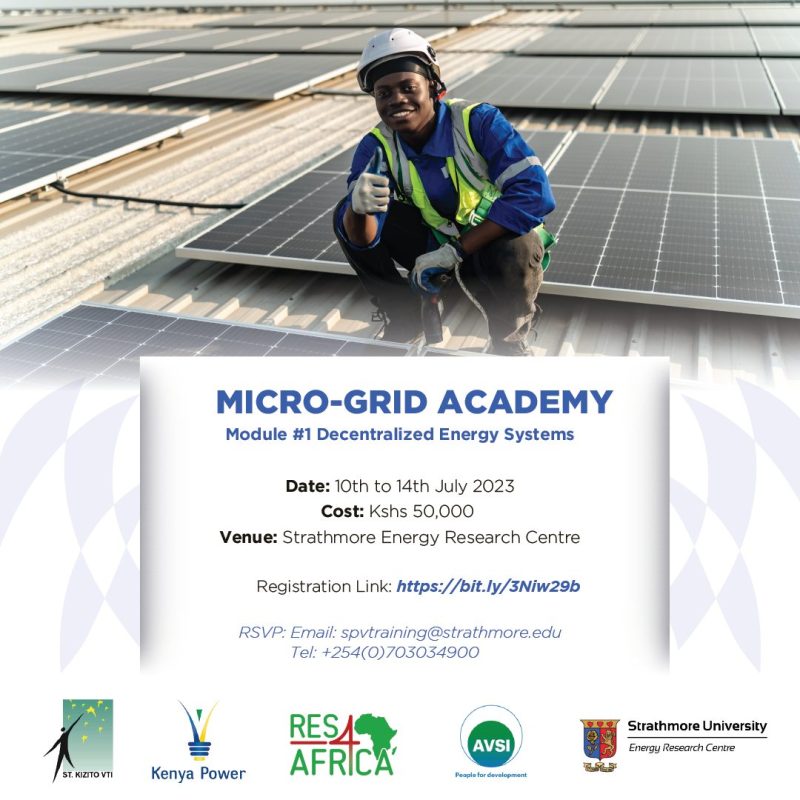
Date: 10th to 14th July 2023
Concept Note: https://bit.ly/3Niahq5
Email: spvtraining@strathmore.edu
Tel: +254(0)703034900

Date: 10th to 14th July 2023
Concept Note: https://bit.ly/3Niahq5
Email: spvtraining@strathmore.edu
Tel: +254(0)703034900
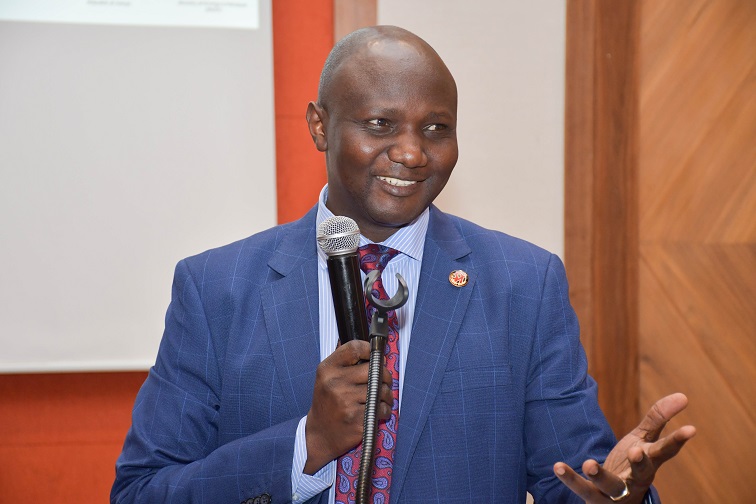
Government officials from the Ministry of Energy and Petroleum (MoEP) and its affiliate agencies (EPRA, KenGen, GDC, Kenya Power, REREC and NuPEA) attended a sensitization workshop on the Kenya Carbon Emission Reduction Tool (KCERT 2050) on 19th May. A first in Africa, this tool is a unique, open, transparent, and interactive model that could assist the country reach its low carbon transitions, to meet the worlds emission targets.
In his opening remarks, Dr. John Olukuru, Head of Data Science and Analytics at Strathmore University emphasized that Kenya is ahead of many countries in developing a carbon emission reduction tool and that there is need to benchmark with other countries like India who have successfully implemented the same. He added that India had achieved beyond what we dreamed. They have a centralized database where everything is channeled to and are currently working on predictive modelling. Dr. Olukuru noted that such specific efforts are necessary to ensure that goals set are met.
The KCERT 2050 tool was developed in 2022 and is now in its second phase. The training workshops on how to feed and use the tool will take place at the national level for various key ministries, state departments and agencies. It is envisaged that a steering committee spearheaded by the MoEP will be formed to periodically update and fine-tune the model. The KCERT 2050 Calculator will also be embedded in the existing curriculum at undergraduate and graduate levels at Strathmore University and other institutions.
Dr. Mutisya, Director in Charge of Energy Efficiency and Conservation at MoEP emphasized the importance of all ministries and parastatals feeding key data in the tool. He further stated that data on energy efficiency, clean cooking and biogas are important to assist pioneer energy planning for the country. This will ensure the tool remains useful and can be used by other counties.
The interactive Carbon Calculator was delivered under the UK Government’s international 2050 Calculator programme, which is funded by the UK’s International Climate Finance, and led by global engineering, management and development consultancy, Mott MacDonald, and a consortium which includes Imperial College London, Climact and Ricardo.
Further, the tool is an evidence-based blueprint supported by existing policies in the legal space such as The Energy Act 2019, the Bioenergy Strategy 2022 – 2027, Vision 2030, The Kenya National Energy Efficiency and Conservation Strategy among others and is aligned to SDG 7, a vehicle to attain the Sustainable Development Goals (SDGs) 2030.
The team will now receive a three-day intensive hands-on training in the month of June.
To learn more on Kenya Carbon Emission Reduction Tool (KCERT 2050) click this link.
This project is led by Patrick Kioko Mwanzia of Strathmore Energy Research Centre and Dr. John Olukuru, Head of Data Science and Analytics.
This article was written by Anne Njeri Njoroge, Communications Officer at Strathmore Energy Research Centre.
What’s your story? We’d like to hear it. Contact us via communications@strathmore.edu
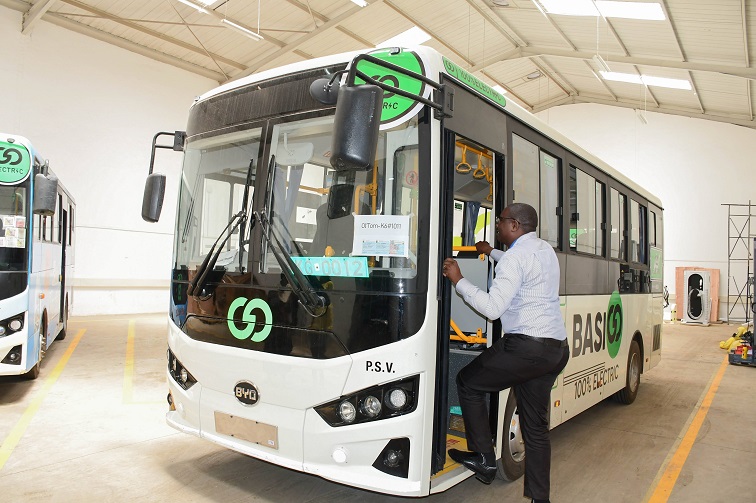
At the end of April, I had my first ride in a BasiGo e-bus from their warehouse in Kikuyu all the way to the heart of Eastlands and finally to ROAM park, a facility newly opened for electric motorcycle production and battery development. I enjoyed the quietness of the bus and the opportunity I had to charge my phone while travelling. The e-bus also offers free WI-FI and piped music. What struck me the most is that I could use my laptop to work while travelling. In the bliss of the quietness, I could catch up with pending deadlines, read a book or just relax while emitting zero emissions to the atmosphere. Sustainable transport at its epitome.
The Sustainable Development Sustainable Transport InterAgency 2021 report by the United Nations states that sustainable transport is central to sustainable development. With impacts across a range of sustainable development goals (SDGs), it is key to achieving the 2030 Agenda for sustainable development and the Paris Agreement on Climate Change. In Kenya, sustainable transport is growing rapidly. While two-wheelers have taken the lead due to the availability of battery swapping stations and the convenience of them anywhere using a standard three-hole socket charger, four wheelers and buses are also gaining traction.
To cement this growth, on April 1st 2023, the Energy and Petroleum Regulatory Authority (EPRA) approved a special tarrif under the e-mobility category for charging of electric vehicles (EV) after it noted that as of 2022, there were 350 and counting registered e-vehicles in Kenya. This new tarrif set at Kshs 17 for energy consumption for up to 15,000 kWh during peak periods and Kshs 8 kWh during off-peak periods will promote Kenya’s agenda on climate change and sustainability.
It’s this growth in the sustainable transport sector that informed an in-depth study.
From December 2022, Strathmore Energy Research Centre, in partnership with Transformative Urban Mobility Initiative (TUMI E-Bus Mission), have been researching the impact of electric vehicles on the grid, and developing a criteria for installing charging stations in Nairobi. This research is in line with the Kenya National Energy Efficiency and Conservation Strategy e-mobility objective to increase the share of EVs by 5% annually of the total imported cars by 2025, and the government’s plan to introduce a Bus Rapid Transport (BRT) system.
A BRT is an exclusive dedicated corridor providing faster travel times and reducing congestion in the city. Elements of rail and road are weaved to the concept. BRT reduces idling in traffic, which in turn improves air quality.
The key objectives of the research include:
The Institute for Transportation and Development Policy (ITDP) Service Plan for BRT Line 2 report found that the service plan estimated peak hour volume as 34,000 passengers per hour per direction and proposed twelve routes along the corridor with direct services to minimize the need for transfers. Further, the operational fleet needed to operate the system is estimated to be 555 articulated buses, corresponding to a total fleet of 611 buses with a 10 percent reserve.
In regards to the power system, before charging station incorporation, the Institute of Electrical and Electronics Engineer (IEEE) 33 bus distribution network test system peak load is 3,715 kW. With incorporation of one charging station at bus 2, the load rises by 1,440 kW to 5,155 kW. When the two charging stations are incorporated, the load increases by 1800 kW to 5,515 kW. The table below gives a summary of load increase with EV charging station incorporation into the distribution network test system.
Look out for the final report, which will be available to the public at the end of July, 2023.This project is funded by the Transformative Urban Mobility Initiative and is led by Ignatius Maranga.
You can contact us at serc@strathmore.edu for more information.
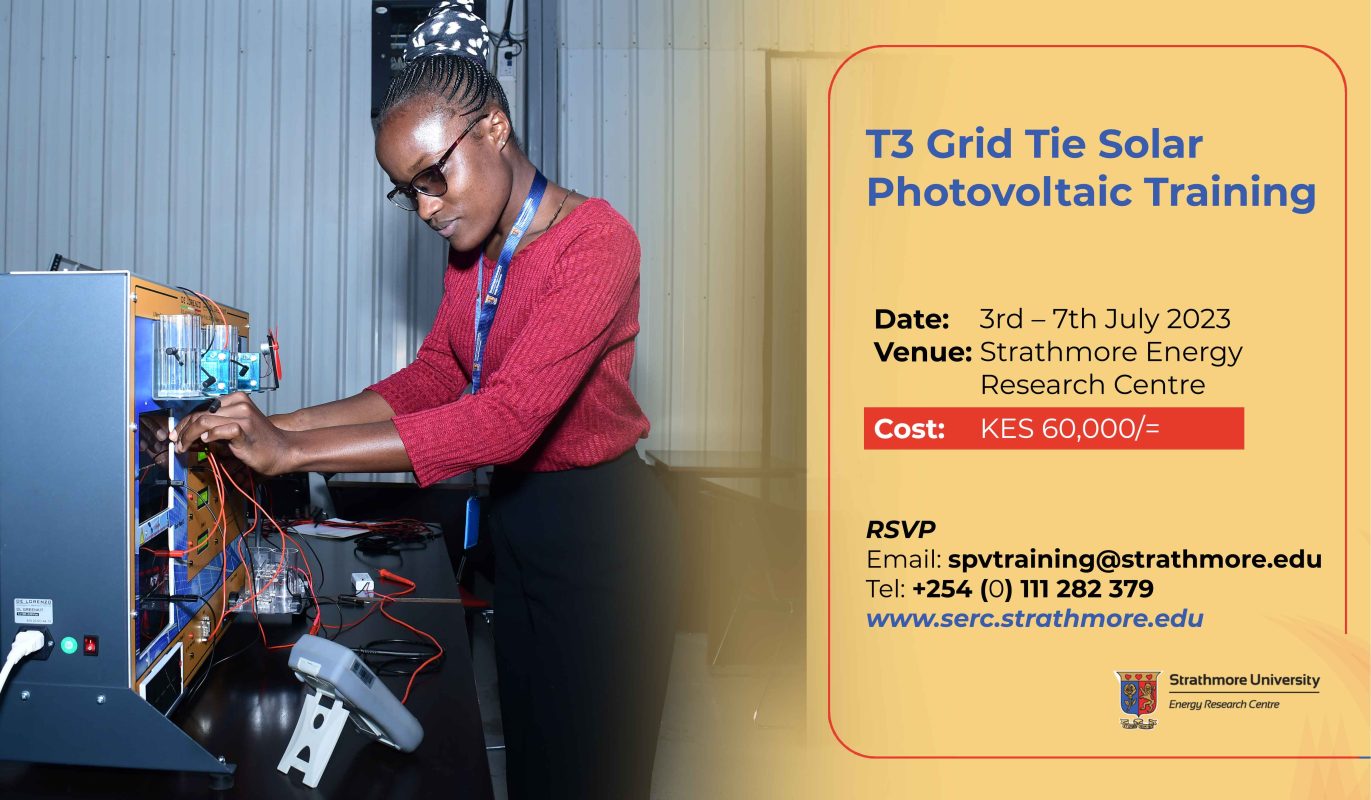
Date: 3rd – 7th July 2023
Venue: Strathmore Energy Research Centre
Cost: KES 60,000/=
email: spvtraining@strathmore.edu
Tel: +254111282379

Date:26th – 30th June 2023
Venue: Strathmore Energy Research Centre
Cost: KES 50,000/=
email: spvtraining@strathmore.edu
Tel: +254111282379

Date: 15th – 19th May 2023
Venue: Strathmore Energy Research Centre
Cost: KES 60,000/=
email: spvtraining@strathmore.edu
Tel: +254111282379
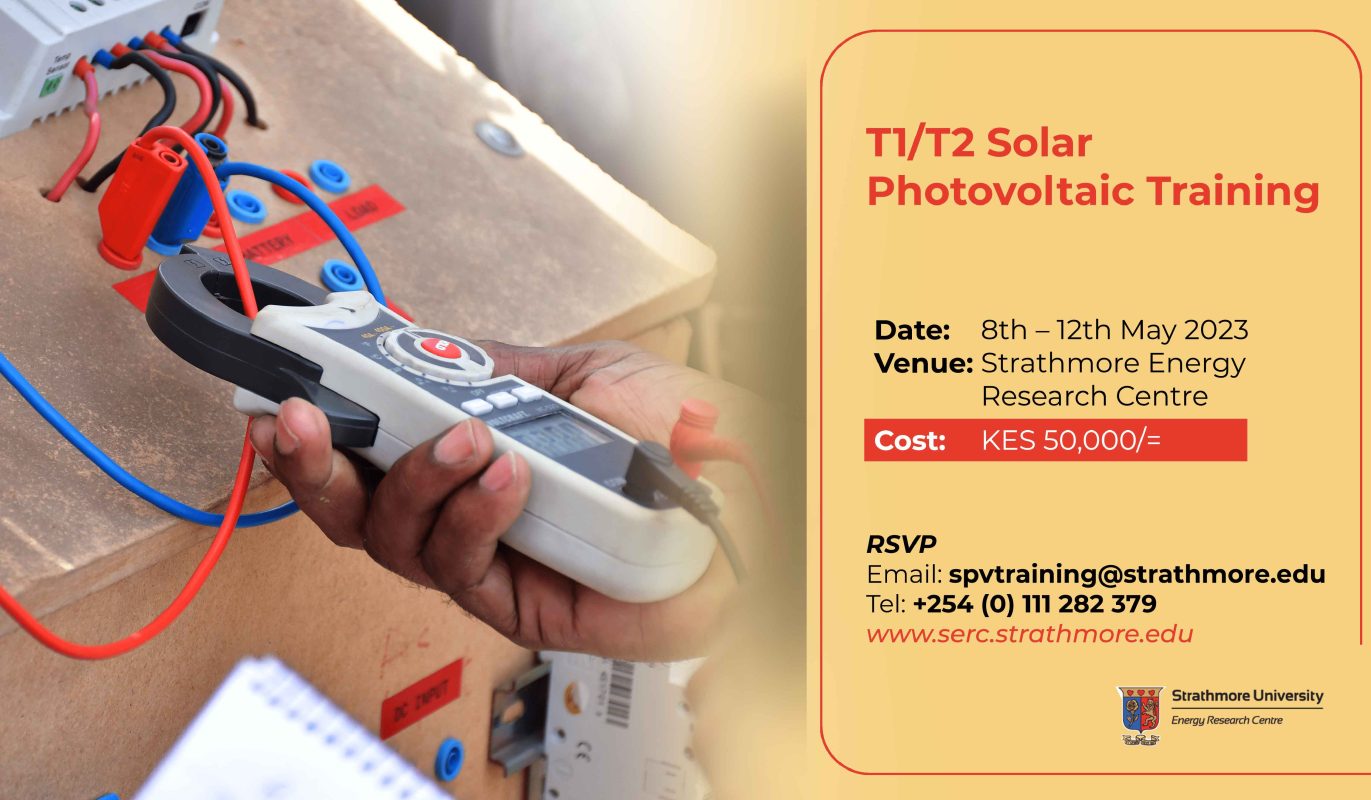
Date:8th May – 12th May 2023
Venue: Strathmore Energy Research Centre
Cost: KES 50,000/=
email: spvtraining@strathmore.edu
Tel: +254111282379

Date:27th February – 4th March 2023
Venue: Strathmore Energy Research Centre
Cost: KES 50,000/=
email: spvtraining@strathmore.edu
Tel: +254111282379
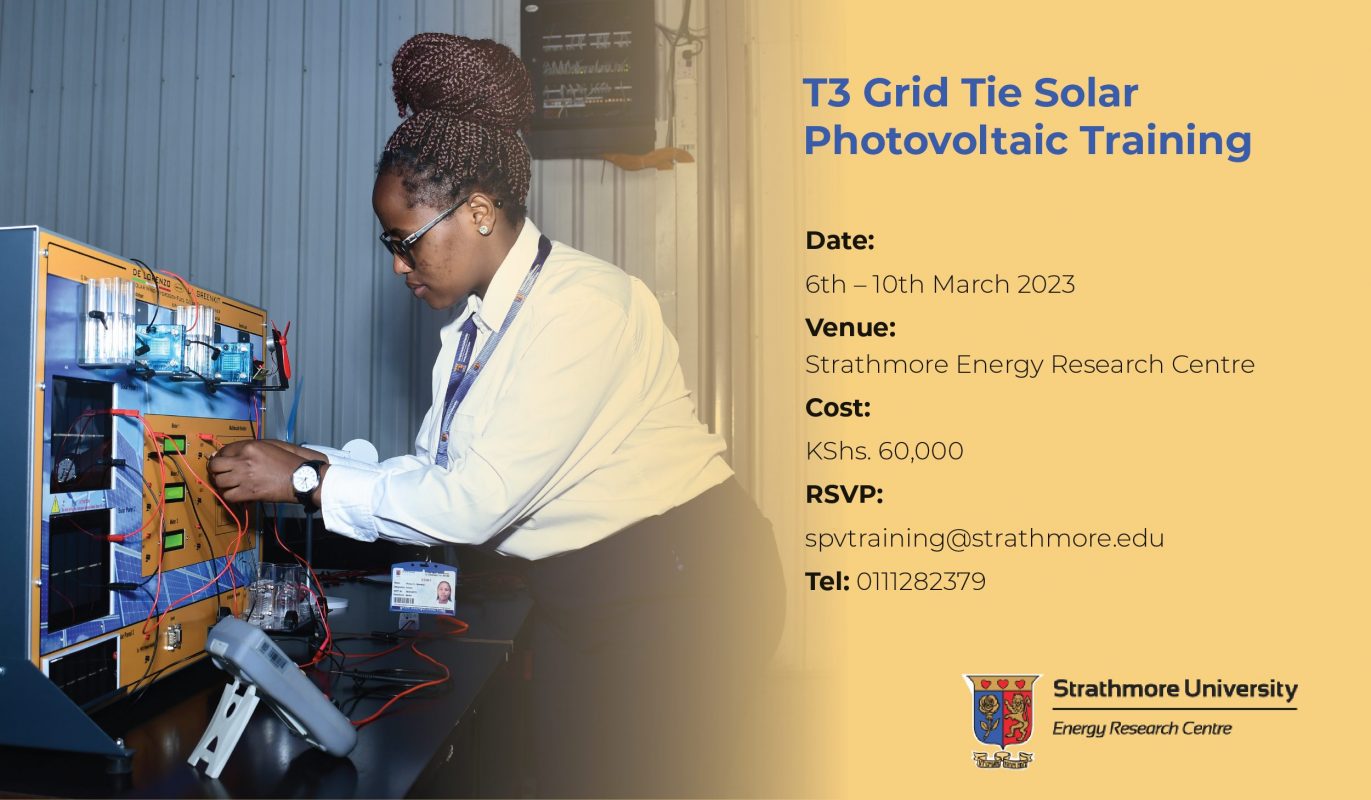
Date: 6th – 10th March 2023
Venue: Strathmore Energy Research Centre
Cost: KES 60,000/=
email: spvtraining@strathmore.edu
Tel: +254111282379
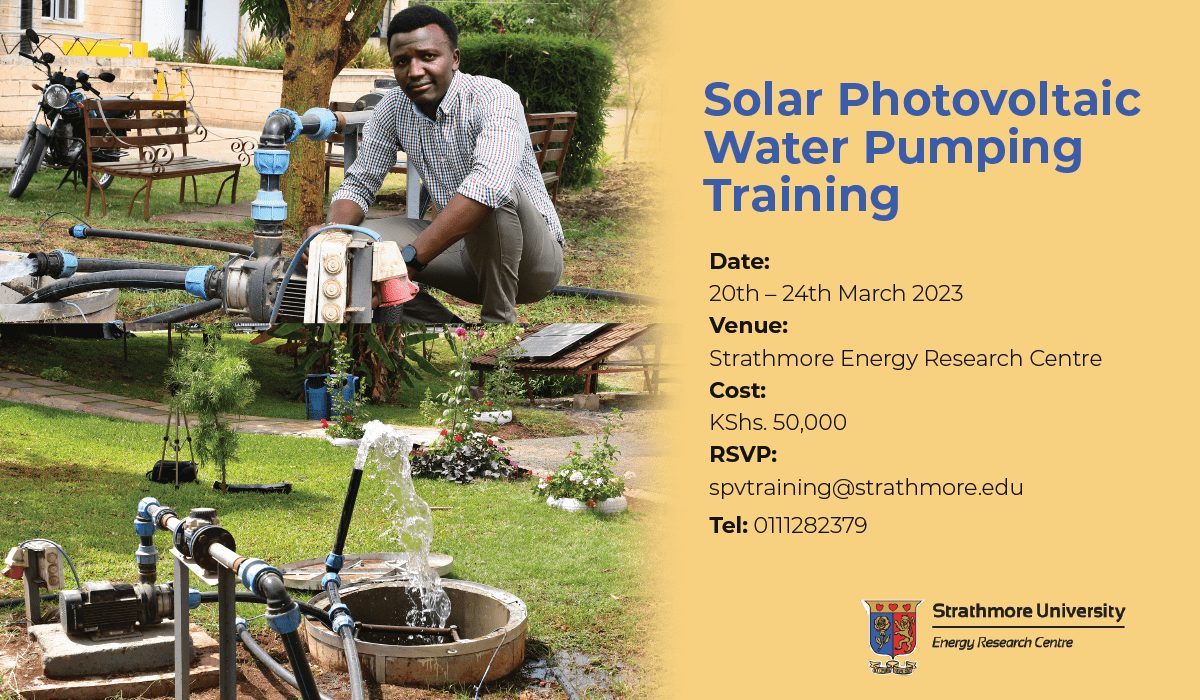
Date: 20th – 24th March 2023
Venue: Strathmore Energy Research Centre
Cost: KES 50,000/=
email: spvtraining@strathmore.edu
Tel: +254111282379